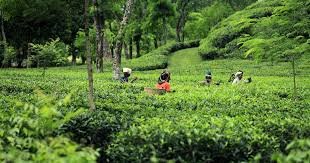Integrating Trees and Crops for a Greener Future
What is agroforestry?

Agroforestry integrates agriculture and forestry, creating a relationship between trees and crops. It establishes farming systems fostering environmental and economic biodiversity, considering social aspects. Agroforestry: Key Sustainable Agriculture includes planting trees in buffer zones, roadside areas, and agricultural landscapes. Agroforestry aims to produce timber, trees, and other commercial products for economic benefits.
Meeting Food Demands and Ensuring Environmental Protection
It also seeks to produce enough fruits and nutritious food for national and international demands. Protecting the natural environment and ensuring carbon sequestration are key objectives. Agroforestry involves protecting, regenerating, planting, or managing trees in agricultural landscapes. These trees interact with crops, livestock, wildlife, and humans.
Sequester carbon from the atmosphere
Climate change is an issue of global concern. Urban trees can help mitigate climate change by storing carbon in tree tissue and sequestering atmospheric carbon, a key greenhouse gas, from carbon dioxide (CO2). Carbon sequestration is the removal of carbon dioxide from the air by plants. A tree absorbs anywhere between 10 and 40 kg of CO2 per year on average, depending on a variety of factors. These complex variables make determining how much CO2 a tree absorbs so interesting.
Bring up water and nutrients from deep in the ground
In an agroforestry system, trees also add nutrients to the soil. Trees with deep rooting systems improve groundwater quality by capturing nutrients and materials, depositing them in the surface and subsurface of the soil. Agroforestry: Key Sustainable Agriculture explored the sustainability. Therefore, soil fertility becomes enriched.

Provide a framework for above- and belowground biodiversity to flourish
The concept of the biological minimum area consists of space minimum, resistance minimum, and regeneration minimum. It deals with the relationships between the permanent survival of species and the size of the plant community or landscape, forming the most fundamental theoretical framework for biodiversity conservation. Belowground biodiversity is calculated as the standardized average diversity (i.e., richness; number of phylotypes) of soil bacteria, fungi, protists, and invertebrates.
Build soil organic matter and thus soil carbon
This conversion factor assumes organic matter contains 58% organic carbon. However, this can vary with the type of organic matter, soil type, and soil depth. Conversion factors can be as high as 2.50, especially for subsoils. You can increase the amount of organic matter in your soil by adding compost, aged animal manures, green manures (cover crops), mulches, or peat moss. Because most soil life and plant roots are located in the top 6 inches of soil, concentrate on this upper layer.
Create regulating micro-climates
Trees are increasingly grown to meet wood and biomass needs globally. This chapter reviews studies on microclimate modifications in agroforestry systems from tropical to temperate regions. We explain the effects of light, temperature, soil moisture, humidity, and wind speed in these systems. It refers agroforestry: key sustainable agriculture
Positive Microclimate Effects of Trees in Agroforestry Systems
Trees in tree-crop associations cause shading, increased humidity, reduced temperatures, and decreased wind velocity. Canopy cover also affects the microclimate of the understory. Literature shows positive microclimate effects on agroforestry, conserving soil, maintaining soil moisture, and protecting crops. Microclimate helps improve the yields of understory crops and trees.
From Hybrid Seedlings to High-Quality Match Splints
A unique poplar improvement program starts with making manipulated crosses among selected parents. Hybrid seedlings undergo multistage screening for 3-4 years at the nursery stage. Local-level screening lasts 8 years, followed by 6-8 years of multi-locational trials. Tests are conducted for growth, yield, insect resistance, and match splint parameters. Wide variation is observed in field and industrial screenings. Match splints require high-quality wood with specific physical and anatomical traits.
Field and Industrial Screening Results for Poplar Clones and Their Diverse Uses
The presentation covers field and industrial screening results for poplar clones. Results compare tissue culture origin poplar to traditionally propagated poplar. Wimco supplies marked wood of identified clones for further testing. Poplar is used for over three dozen products, with the panel industry having the maximum share. Marked clonal wood has been supplied for trials for other end uses. Results of some clonal screening trials on other products are also included.
Provide fodder and shelter for livestock
This briefing examines the role of silvopastoral agroforestry in providing livestock with nutrients via tree browse, alongside the many other benefits of trees. Fodder trees and hedges are planted along the border as live fences. Trees like Sesbania grandiflora, Gliricidia sepium, Erythrina abyssinica, Euphorbia spp.
Utilizing Acacia spp. and Katkaranj for Forage and Livestock Shelter
Acacia spp., Katkaranj, etc., can be used. In this system, various trees and shrubs are scattered irregularly or arranged according to a systematic pattern, especially to supplement forage production. The canopy of these species is comparatively larger, providing shelter for livestock.
Innovate diversified farm enterprises
Products or services are the basic elements of businesses or enterprises. Services correlate with products. However, products require raw materials and a manufacturing process. Agroforestry is a principal source of raw materials. Employment generation and small, medium, and large enterprises depend on agroforestry. Agroforestry: Key Sustainable Agriculture focused to learn the crop economics.
Hedgerows, Windbreaks, and Long-Term Profit Strategies
Agroforestry practices range from planting hedgerows to creating windbreaks or riparian buffers. Interspersing crops between rows of trees and other perennials can yield long-term profits. Managing less productive land can help focus on productive farmland.
Rising Carbon Prices and Innovative Agricultural Advancements
Woodland-generated carbon prices have risen over the past 2-3 years. Tilhill’s Carbon Store secures competitive prices for carbon-offsetting services. Innovative advancements include precision farming with drones, genetically modified crops, vertical farming, and precision irrigation. Agroforestry: Key Sustainable Agriculture works on CO2 emission.
Make agricultural landscapes more resilient
Resilience means being able to recuperate from shocks and negative impacts – in this context, impacts related to climate change, such as severe storms and droughts. For smallholder farmers, these shocks can exhaust scarce resources of cash, seeds, and livestock.
Shielding Farmers from Climate Challenges
Including the use of biotechnology and the development of resilient crops that can withstand various harsh conditions (that could otherwise obliterate harvests and food stores), farmers can recover from and/or be immune to the above-mentioned climate challenges.

The Agroforestry Situation in Bangladesh
In short, there is nothing better than a tree. The total forest area of Bangladesh is 2.6 million hectares, which is nearly 17.4% of the total land area of the country, according to the Bangladesh Forest Department. However, additional information suggests that the largest mangrove forest, Sundarban, is in Bangladesh.
Alive but Falling Short
Shalban and Modhupur forests are also alive but still fall 9% short.. The forestry sector accounts for about 3% of the country’s gross domestic product (GDP) and 2% of the labor force. Agroforestry: Key Sustainable Agriculture refers falling shorts too.
The way of destroying forestry
The Forest Department of Bangladesh allows membership cards for harvesting trees and collecting honey. They also allow fishing in the Sundarban mangrove forest. This opportunity threatens Sundarban due to uncontrolled tree cutting and goal collection. Chemical use for fishing destroys biodiversity and decreases forest animals.
Ethnic Communities, Deforestation, and Declining Elephant Population
The ethnic community of Modhupur and Shalban forests faces threats due to forest destruction. The forest area decreases daily as ethnic people cut trees for homes. The Forest Department of Tangail cannot act due to political embargoes. The elephant population is also decreasing in this area.
Is there any hope to scale up agroforestry?
Many agricultural projects are scaling up agroforestry, making it essential for regenerative agriculture. Global warming’s impact is evident through cyclones, droughts, and heatwaves. Therefore, Bangladesh recognizes agroforestry’s importance for its 18 crore population.
Celebrations, Tree Fairs, and Environmental Initiatives
The Bangladesh Forest Department celebrates National Tree Plantation Day and World Environment Day on June 5th. This day features the largest tree fair in Dhaka, inaugurated by the Prime Minister. After the one-month national tree fair, divisional and district tree fairs follow.
Community Initiatives and International Collaboration
Community organizations, CBOs, and volunteers initiate tree distribution and plantation. German and Korean brands are also working on climate change with a focus on agroforestry.

Pingback: Best Agroforestry Species for Bangladesh - Carbon Revolve
Pingback: USDA's Agroforestry Strategic Framework - Carbon Revolve